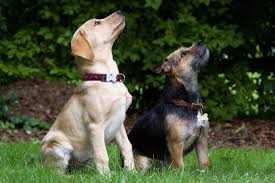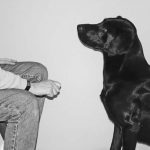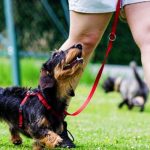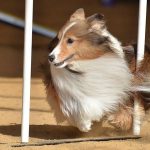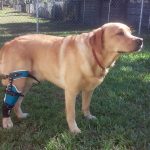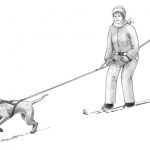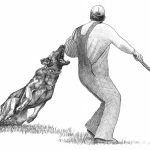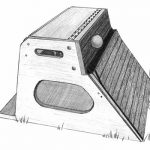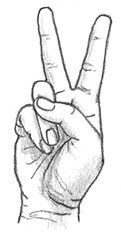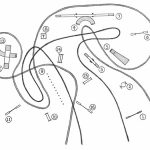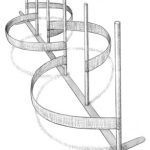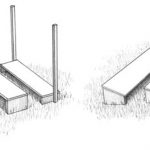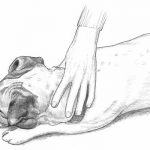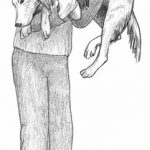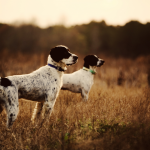- Doing tricks that show happiness and affection
- Playing games together
- Teaching paw tricks
- Getting your dog to roll
- Teaching begging tricks
- Encouraging stretches
Like people, every dog has different likes and dislikes, games they enjoy, and routines that they count on. When your training comes from a consistent, patient, and understanding place that takes these canine preferences into consideration, your dog will master tricks and activities quickly and enthusiastically.
Teaching interactive skills is your first trick. And as you’ll see, it isn’t complicated at all. In this chapter, you find out some tricks you can teach so your dog uses those barking, chewing, and jumping instincts in a socially acceptable way, and some simple tricks and games you can play together.
Before you dive into the dog tricks in this chapter, keep the following tips in mind:
– Know when to practice. Some games are designed to burn energy. Play these when your dog is full of beans. Other tricks are just for fun; when your dog catches on, she’ll want to practice as much as you.
– Keep the sessions short and sweet — no more than five to ten minutes. Several short lessons are better than one long one. With a positive attitude and the building-block approach, your dog can master these techniques in no time.
– Try a clicker. In Chapter Teaching Your Dog Manners, I discuss the use of a clicker. Although this little hand-held device isn’t mandatory for trick training, it can be useful when teaching complex tricks like the ones in this chapter. The sharp sound paired with a tasty food reward helps your dog know exactly which behavior you’re after.
– Avoid forcing your dog to do certain tricks. Tricks like rolling over and begging are very entertaining, but please don’t force your dog if she’s not into it. Some dogs love to act silly; others don’t or can’t do it without discomfort. How do you know? If your dog naturally rolls around or easily sits back on her haunches, you have the green light! If rolling on the floor is beneath her standards or physical capabilities, don’t force it.
Some Simple Moves: Tricks for a Happy, Loving Dog
One of the fastest ways to get addicted to trick training is to teach your dog some easy tricks that showcase that puppy love. And dogs, like people, love to succeed, so the surest way to get your dog addicted to trick training is to start with a few surefire winners. Here are a few tricks that everyone can master — people and dogs of all ages.
Wag Your Tail
If you’re happy and you know it, wag your tail. Teaching your dog how to wag his tail on command is so easy. If a tennis ball brings the tail into action, hold up a ball; if food gets the tail to wag, use that. Catch your dog wagging, praise him for it, and think of a clever cue word to command each time (like “Wag”). Use your cue word in a positive, inviting tone and watch your dog come alive.
Now add a hand signal like waving your right hand back and forth. Start out with a pronounced sweep, and then phase off until you can make small motions with your index finger.
If you’re in front of a crowd, you can ask really difficult questions and tell your dog that if he agrees, all he has to do is wag his tail. It goes like this: “I’m going to ask you a hard question and if you agree, all you have to do is wag your tail. Ready? Would you like everyone to give you a hug?” Signal your dog, and voilà — a surefire crowd pleaser.
Give Me a Hug
Warning!
Give Me a Hug is a breed-selective exercise. If your dog is injured, has dysplasia, or is skeletally challenged (like a Basset, a Bulldog, or a giant breed), avoid this trick. And don’t forget — if your dog refuses, move on.
You can teach this command in several ways. If your dog loves to wrapher paws around you, you can reinforce this behavior when it’s happening by using a clicker or you can cue your dog by luring her and pairing her cooperation with a word like “Hug.” Reward your dog when she’s in the hug position — this method works best for calm dogs who are not prone to excessive jumping.
For jumpy dogs, try a more sedate method. Ignore the behavior when she jumps all over you and then sit with her and organize it this way:
1. Kneel down on the floor or sit in a chair and give your dog the “Sit” command.
Check to make sure that your dog is sitting square on the floor, not leaning to either side.
2. Lift your dog’s front paws gently and place them on your shoulders as you say “Hug.”
Give your dog a thorough pet and/or a reward.
3. Say “Okay” and help her down.
Do Steps 1 through 3 only three times per session — stop if your dog becomes too energetic or starts to nip. Leave the leash on and give a tug on the leash as you say “Shhh!” if your dog gets too excited while on two paws. Also, try practicing “Hug” when your dog has less energy.
The silent signal for Give Me a Hug is to cross your arms over your chest and tap your shoulders with your fingers. You can demonstrate the signal each time you say “Hug.” Be patient while teaching this sign language — it may take a while for your dog to make the connection.
Kisses!
Getting your dog to give you kisses is a real delight — unless you hate dog kisses. You can teach this trick quickly by association, simply saying “Kisses” whenever you’re getting a licking.
If your dog is licking out of control, make it more of a two-step process:
1. First teach your dog “Enough” to signal him to stop licking.
Keep a short (8- to 12-inch) leash on your dog and say “Enough” in a pleasant but serious tone. If your dog doesn’t listen, tug the leash as you withdraw your attention.
Remember
When discouraging licking, look away and not at your dog. If you look at your dog, you’re essentially saying, “Do it again!”
2. Teach your dog to lick on cue.
To teach your dog to lick you, take a frozen stick of butter and rub it on the back of your hand. During a period when your dog is calm, go to him, extend your hand, and command “Kisses” as he licks your hand. When you’ve had enough, just say so — “Enough!”
To teach your dog to give someone else a kiss, such as the next-door neighbor or a member of your audience, use a stick of butter during the teaching phase. Ask a few people to help you out, and rub the backs of their hands with butter before you instruct your dog to give them a kiss. Have them extend their hands to your dog and say “Kisses” as you point to the buttered hand. Soon your dog will be seeking out hands to kiss, butter coated or not. This trick is handy if you have kids over; putting butter on their hands encourages licks, not jumping.
Tip
When your dog knows the trick, you can add a hand signal: Rub your right index finger on the back of your left hand, as though your finger is your dog’s tongue.
Introducing Interactive Play
Dogs love to play. The more you can let go and roll with their enthusiasm, the more fun you’ll have. Some games, like tug of war and wrestling, inspire confrontation, so use the games in this section instead to increase your fun. Interactive activities like Hide and Seek and Catch Me can build your bond and inspire respect.
Hide and Seek
Hide and Seek is a great game and also reinforces that indispensable “Come” command. You need one to four players and a treat cup, and your dog needs to know his name and the “Come” command. “Stay” also comes in handy.
Start with this game inside, one-on-one:
1. While your dog is occupied, go into an adjoining room with a treat cup; call out his name and shake the cup.
Use a disposable plastic cup filled halfway with small treats, such as Cheerios.
2. When you hear him running, say “Come” clearly.
Praise him, offer a treat, and let him return to whatever he was doing, putting the treat cup away — or he may never leave your side.
3. Increase the level of difficulty by calling him from two rooms away.
You should still be in sight, not hard to find.
4. After a couple of days of hiding in plain sight around the house and calling from room to room, go into the adjoining room and hide behind a chair.
After your dog catches on to this game, you can increase the difficulty of your hiding places and add another teammate. Eventually, your two-legged geniuses can play a game to see who gets found first and who gets found last. Gradually phase off using your treat cups.
Where’s Sally? The name game
Teaching your dog everyone’s name couldn’t be easier. Pick one person at a time and have the person sit across the room with a treat cup. Instruct your dog to find that person by name. For example, say “Where’s Sally?” and have Sally shake the cup the moment she hears her name. Progressively ask Sally to distance herself from you, having her in various rooms of the house so your dog will always be curious to find her location.
After your dog is eager to track Sally (and her treat cup), reintroduce her nearby — but phase off using treats. Sally can call and encourage your dog with praise instead. Soon just her name will inspire enthusiasm.
The Shell Game
Dogs love to be included in the Shell Game. Whether you’re sitting at home or on an adventure, you can use shells, cups, or even sand piles to hide your dog’s treat or toy under one of three stacks. After you shift the stacks about, ask your dog, “Where’s your bone?” or “Where’s your toy?” If your dog’s confused, pretend to sniff each pile — he’ll copy your example and find the bone or toy soon enough.
Catch Me
Games that encourage your dog to focus on and follow you are a real prize when it comes to training and having fun. These games also reinforce the extinction of bad habits, such as nipping and jumping.
To play Catch Me, a variation of the children’s game Red Light, Green Light, you need one or two players and a dog toy. Your dog needs to know “Sit,” “Wait,” “Down,” “Stay,” “Okay,” and “No.”
1. Turn and face your dog from about 3 to 6 feet away; say “Catch me” and then turn and run.
2. After a few feet, pop back to face your dog and command “Wait!”
3. Treat your dog when she stops; then say “Okay, catch me,” and run again.
4. Now that she’ll stop, try another quick command like “Sit” or “Down,” luring your dog into position if she’s confused by the excitement.
5. Follow each stationary command with “Okay, catch me” to continue the game.
6. When you’re through, tell your dog “Okay” and give her a favorite toy.
Keep the game short, just one or two minutes.
Warning!
Some dogs get too excited or overwhelmed by this game. If yours isn’t cooperating, try a different game. If she goes wild, racing in a big circle playing hard to get, guess what — this isn’t the game for you.
Don’t high-energy games encourage mouthing and jumping? If it escalates the dog’s bad behavior uncontrollably, leave it out. If your dog enjoys the game and you can curb naughtiness with a sharp “No,” then go for it. Catch Me is a fun activity and sharpens your dog’s impulses, teaching her to follow — but not jump or nip at you.
Digging for China
Have you considered hiring your dog out to the local excavating company? The prerequisite, of course, is to teach him to dig on command. Equip yourself with a clicker, garden gloves, and treats, and then follow these directions to play Digging for China:
1. Find a private area in your yard to teach your dog to dig; bury some treats 1 inch under the ground to pique his interest.
2. Start blissfully digging yourself, unearthing the treats as you go and handing them to your dog.
3. Reward your dog for joining in, saying “Go dig!”
4. Now try hiding a few treats or a toy before bringing your dog to his digging spot; then give the command “Go dig.”
Like an archeologist discovering treasures, he’ll unearth them with obvious delight.
You may be worried that without your approval, your dog will unearth your shrubbery and carpets. However, although there’s no guarantee, most dogs who are reinforced for digging in one area usually stick to it. By teaching your dog to dig in specific locations, you may be able to discourage him from digging in other places.
Playing with the Plain Ol’ Paw
Nothing like starting with a classic: Giving a paw. Some dogs are naturally predisposed to giving a paw, so much so that you’re probably wondering how to teach “No paw” (see the sidebar “Getting dogs to keep their paws to themselves”).
After your dog masters “Paw,” you can really start being creative, teaching her to wave, give high fives, and turn out the lights. But everyone’s got to get started somewhere — after you master the basic “Paw,” the sky’s the limit.
Doing the basic Paw
To teach the basic “Paw,” first get your dog (on a leash if he’s antsy) and some favorite treats, and go into a quiet room. Then do the following:
1. Kneel or sit in front of your dog.
2. Command “Sit,” positioning your dog’s hindquarters if necessary, and offer praise.
3. You can try two methods at this point:- Physical: Using a thumb, press your dog’s shoulder muscle gently until his front leg lifts. Then lay your hand under his foot pad as you say “Paw.”
- Treat-based: Hold a treat in a closed hand a couple of inches in front of your dog’s foot. When he paws it, open your hand to reward him. With each repetition of this step, gradually raise your hand to your dog’s elbow. Now add the Paw step. Keep the treat in your other hand, as you extend your closed hand. As he hits your hand, say “Paw” and gently grasp his paw with an opened palm. Treat him the moment your palm connects to his paw.
4. Now signal and command “Paw.”
Is he catching on? If not, help him complete the Paw by pressing his shoulder blade gently. Praise him warmly, whether he caught on or needed your help.
The hand signal for Paw is to stretch out your hand, as if to shake hands.
Paw variations: Shaking things up
Shaking paws is great, but you can easily teach a few variations that will delight you, your pup, and any onlookers. In this section, you find some new cue words and variations on the basic Paw.
Say Thank You
Hold out your hand as if to shake hands. At first, say, “Paw — Thank you.” Fairly soon she’ll respond to both your signal and your new directional cue. Praise your dog for placing her paw in your hand and give her a treat.
Now get a human pal to help you out. As your human pal extends a hand, command “Paw — Say thank you” and encourage your dog to offer her paw to your friend. Now you’re ready to spread your dog’s good manners everywhere.
The hand signal for Say Thank You is the same as for the Paw trick — extend your hand to the dog with your palm up.
Wave
A dog who knows how to wave hello and goodbye — miraculous, you say? Actually, it’s not hard to teach at all. Here’s how:
1. Place your dog in a sit-stay and show her that you have a treat in your left hand.
2. Standing in front of her, say, “Paw” and signal with your right hand (as if you were going to shake hands).
3. As she lifts her paw, wave your signal hand and say “Paw — Wave” as you reward her with the treat.
4. Repeat this, slowly weaning off the initial Paw signal in place of a wave signal, simply waving to your dog while saying, “Wave hello” or “Wave bye-bye!”
Other One
As your dog gets into the Paw trick, you may notice that he favors eitherhis left or right paw. To prevent having a one-dimensional dog, teach the cue Other One. Here’s how:
1. Say “Paw” and lovingly praise your dog when he raises his paw.
2. Extend your hand to the other paw and say, “Other one,” using the treat-on-on-the-floor trick or shoulder press to inspire hiscooperation.
Hold the treat in a closed hand a couple of inches in front of your dog’s foot until he paws it, or press the shoulder muscle gently with your thumb until he lifts his paw, as described earlier in the section “Doing the basic Paw.”
3. If your dog lifts his favored paw, use a sound such as “Nope” and repeat your original request while you put pressure on the shoulder muscle of the other leg.
When your dog lifts the other paw, praise, treat, and give him a big hug (if your dog likes that sort of thing).
The hand signal for Other One is to stretch out your hand to the specified paw.
Right Paw, Left Paw
By using Other One to get your dog to pay attention to which hand you extend, you can pull off a trick that makes it seem as if your dog can tell her right paw from her left, the little genius!
While in a quiet room, decide which paw your dog gives most frequently. For this example, say it’s the right paw. Exaggerate the Paw hand signal as you hold your right hand to her right side and say, “Right paw.” Praise and offer a treat. Have your dog do this right three times in a row so she gets plenty of positive reinforcement. If by chance your dog swaps and offers a left paw, say “Nope” and wait to reward until she offers the right paw.
Now for the other paw. Exaggerate your hand signal toward the left side and say “Left paw.” Your dog will probably try the right paw. If she does, say “Nope — Other One.” Show her physically if you have to. Practice three lefts, and then stop.
The next time you go to practice, start with “Right paw,” accentuating your signal. Help your dog out if you must. Do three rights; then three lefts, accentuating the left signal. Soon your dog will catch on, and you can mix it up: two rights, two lefts, two rights, one left, one right, and so on. Vary the pattern each time and keep these mind-puzzler sessions short. As your dog becomes clued in to your body language, you can exaggerate the hand signal less and less.
Celebrating success: High Five and Go for Ten
Getting your dog to give you five — or ten — is easy to teach, and dogs love it. Afterward, you’ll both have something to celebrate. Here’s how these tricks work:
– High Five: To teach High Five, simply hold your hand palm out at the same height you normally do when you say, “Paw.” If the command High Five gets a puzzled look, then say, “Paw” to request the action and say, “High Five” as the dog’s paw makes contact with your hand. Drop the Paw command when your dog makes the connection. Slowly lift your hand higher to accentuate the High Five.
Tip
When asking for the High Five, stay within your dog’s height capabilities. If you hold your hand too high, your dog will leap up to try to please you, but you don’t want to encourage jumping. High Five is a three-paws-on-the-floor trick.
– Go for Ten: This trick involves two hands and two paws. When saying “Go for ten,” keep your hands at about the level of your dog’s head. Any higher will encourage jumping. At first your dog may only reach up to hit you with one paw . . . after all, that’s what he’s used to. Reaching up will encourage him to stretch up and bring his other paw off the floor — at this point, tuck your free hand under his paw and praise him the moment both paws connect with your hands.
Remember
Some dogs simply can’t sit up on their hind legs. You know if your dog can’t do Go for Ten. So what? You love him anyway.
Hit It! Targeting paw tricks with lights, doors, and music
After your dog knows how to Paw, you can teach her to target an object and then use the object’s placement to help her learn to play music, close doors, and work the light fixtures . . . before you know it, your dog will be saving you a bundle in electric bills.
Hit It
After your dog knows Paw (see the earlier section, “Doing the basic Paw”), establish a target object, such as a container lid or business card. Then do the following to teach your dog to strike it with his paw:
1. Present the target object in the palm of your hand and command “Paw.”
2. The moment your dog hits the object, say, “Hit It”; give your dog a treat (or click and treat) and offer praise.
3. Phase off holding the object flat in your hand, holding it at the same level but pinched between your thumb and forefinger.
Repeat this until you’re able to hold the object out and your dog will paw it when directed with the Hit It command.
Your next goal is to place the object in various locations to encourage your dog to do things like turn out the lights and close doors. This section includes three tricks that do just that.
Close It
After your dog learns how to Hit It, you can parlay that one behavior into a whole host of cool, helpful, and unique tricks, such as closing the cabinet, turning out the lights, and playing the piano! Though these tricks might sound like magic, it all boils down to the placement of the target object.
When teaching your dog to close cabinets and doors, she may be initially startled by the sound the door makes as it shuts. Before asking her to tidy up for you, place her in a Sit-Stay next to the hinge and give her a treat as you open and shut the door gently. She will soon get used to the sound of its opening and shutting.
At first, hold the target object near a cabinet door at what would be a normal Paw level for your dog — about her elbow. Do a couple Paws (see the earlier section, “Doing the basic Paw”), holding your hand near the door. Next, encourage her to paw the object by saying “Hit it.” If she has a light touch, encourage her to really whack the object by egging her on and withholding the reward until she does.
Next, tape the object to the outside of the opened cabinet door. Kneel close to your dog and point to the object. Reward each attempt to strike the door with her paw. After two days, withhold the reward until a successful closing.
Over the course of four days, gradually start combining the new command with the familiar cue: Hit It — Close It. Phase out the Hit It command so Close It will mean just that.
Lights
Teaching your dog to turn out the lights requires blending the Hit It command with a jumping sequence. If your dog is tall and agile enough to reach the switch, he’ll be more than happy to oblige you.
To begin, get a light switch like the ones on your wall. Use your target object to teach your dog to Paw It and to get comfortable with its feel. Tape the target object above the fixture and hold the fixture in your hand initially.
At first, hold the switch at a normal Paw level — about your dog’s elbow — and pair the command Hit It with “Lights” as you encourage his cooperation with praise and rewards. This will seem awkward at first for your dog, who isn’t used to things moving when he paws them. Use your praise to encourage him and rewards to emphasize the moment his paw connects with the switch.
Separately teach your dog to jump up on the wall by the switch. Pat the wall and teach Up, guiding your dog there with a treat if necessary. At first, all your dog needs to do to earn a reward is jump up and stand against the wall.
Gradually lift your practice switch higher and higher until it’s at the height of the real switch. Each time, prompt your dog with the command Hit It — Lights. At first, reward and praise your dog if he touches the switch. After four days of practice, reward him only if he activates the switch. When he’s got it down pat, phase off the Hit It command and emphasize Lights.
Now that you’ve connected the dots, try this trick in the real world. Move to other switches in your home, using the pretend switch step if your dog acts confused.
Piano
All you need to teach your dog to play the piano is a keyboard, a target object, and the Paw command. Here’s how it works:
1. Teach your dog to paw a target object.
See the earlier section, “Hit it: Targeting paw tricks with lights, doors, and music.”
2. Place the keyboard on the ground and place your target object on it.
3. Pair the command Hit It with “Piano.”
4. Move the object to various spots on the piano.
The hand signal for this trick is to pretend your fingers are tapping an imaginary keyboard.
Getting dogs to keep their paws to themselvesIs your dog too paw-expressive? It happens to the best of them. If your dog constantly paws, you have two options: Ignore her, or use a mild correction. Ignoring is self-explanatory; you may simply walk away. If that doesn’t work, try one of the following corrections: – Keep a short tab (a very short loop of leash) on your dog and snap it downward while saying, “Not now.” (You can buy a short lead — 8 to 12 inches — at a pet supply store.) – Say “No” and command “Sit.” Remember that dogs usually paw because they want something: a treat, a toy, or attention. Avoid giving in to your dog’s pestering. You’re just teaching her that it works. Wait for more mannerly behavior, such as sitting quietly or lying down, before you give your dog what she wants. |
Roll Over
Dogs who are as comfortable on their backs as they are on their paws really groove with Roll Over. How will you know whether your dog qualifies? He’ll roll anywhere, anytime, and often of his own volition. He’ll sleep on his back. He’ll scratch his back by rolling on the carpet. He’ll come in with a grass-stained coat from rolling in the yard.
Although teaching Roll Over requires some patience, it demonstrates the importance of sequencing — breaking the sum of a trick into parts and then linking the parts to perform the trick.
Before you begin, bring your dog into a quiet room and place treats on a nearby table. Find your clicker if you’re using one. Here are the three training sequences:
1. First sequence: Call your dog to you and put him in a Down-Stay. Kneel next to your dog and scratch his belly until he lies on one side. As he does so, say, “Roll”; then reward and praise him. Repeat this sequence 10 to 20 times until your dog responds comfortably to this direction.
2. Second sequence: Repeat the preceding steps. Then take a treat and circle it from under your dog’s chin to just behind his ear. As his head twists to follow the treat, his body will rock to the side. Say, “Roll,” offer a treat, and praise him. Repeat this sequence 10 to 20 times until your dog responds quickly.
3. Final sequence: Repeat the preceding steps. Now circle the treat slowly backward over the back of your dog’s head as you say, “Roll Over.”
Tip
When your dog is first learning to roll over, he may need some help. Guide him over by gently pushing his top front leg to the other side as you say the command.
Click (or say “Yes!”) and give your dog a treat whenever he does a full roll, whether you helped your dog or not.
As soon as your dog gets the full roll sequence, practice a few times and then quit on a high note.
Roll Over with a hand signal
When your dog is comfortable rolling over, you can teach a simple hand signal to prompt this trick:
1. Continue to kneel next to her when commanding “Roll Over,” but lean backward in the direction you want her to roll.
2. Hold your index finger parallel to the floor, and draw small circles in the air as you give your verbal command.
3. Help your dog initially if she seems confused, praising her as you assist and jumping up with her to end the trick.
4. As soon as she responds to the cue without your help, stand up and give the command and the hand signal, always accentuating your hand signal.
Tip
Your end goal is to direct your dog from a standing position. Gradually move up from a kneeling position to a one-kneed bend to eventually standing up, as you overaccentuate your hand signal.
After your dog seems able to follow the command, you can teach her to keep on rolling or to jump up after the first roll. Using enthusiastic body language, you can easily communicate when you want your dog to jump up. Toss your arms in the air and jump like a bunny when you’re encouraging your dog to leap up.
If you want your dog to continue rolling, lean in the direction she’s rolling and exaggerate your signal initially.
Pump your clenched fist in an enthusiastic hooray to signal your finishing roll!
Roll Over from a distance
When your dog knows the hand signal — drawing circles in the air with your index finger — you’re ready for control at a distance. Here’s how to cue your dog to roll from farther away:
1. Place your dog in a Down-Stay and stand back 3 feet.
2. Use your hand signal, leaning your body in the direction you’re sending your dog, as you command “Roll Over.”
If your dog looks confused, go to him calmly and help out, getting back into your starting position as he finishes the trick.
When he performs on his own, give him a jackpot — a whole fistful — of treats and end with a fun game.
3. Back up 2 feet at a time during your subsequent practice sessions, until your dog will roll over at a reasonable distance from you.
Visualization helps you teach a trick, so create a picture in your mind of your dog performing the trick flawlessly. Can dogs read minds? Who can prove they can’t?
Ain’t Too Proud to Beg
“Beg,” “Ask nicely,” “Put up your paws” — take your pick of a verbal command — they all mean the same thing! Getting your dog to sit up on her back legs (or haunches) is a real charmer. Some dogs come by this trick fairly easily. Others aren’t as coordinated and need help up. Either way, this section explains how to teach your dog to beg.
The naturals: Teaching the art of begging
Some dogs are born beggars. Your dog may have even discovered the begging trick by himself during one of his more-successful ploys to get attention. If your dog is a natural beggar, praise him each time he offers you the begging behavior. Soon you’ll have a smart aleck on your hands who sits up at every opportunity, and you’ll have no trouble getting him to beg on cue.
Here’s how to teach the begging trick:
1. Command “Sit” and make sure that the dog is sitting squarely (not leaning to either side).
Tip
If your dog is relatively coordinated but often gets a little too excited about food rewards —he’s jumping, turning inside out, and basically unable to sit still — make him part of the “Corner Crew”: Start the dog out in a corner of the room to help him feel more secure. Tuck his back end toward the wall. The walls on either side help limit and guide his movements. If he’s super-excited, practice when his energy is lower, such as late in the evening or after a good romp.
2. Take a treat and hold it an inch above his nose.
3. As he stretches to sniff the treat, bring it back slowly between his ears as you command, “Ask Nicely.”
The dog should rise up to follow the path of the treat.
4. Click (or say “Yes!”) and reward the dog’s split-second attempt to sit up.
After he catches on, hold out on rewarding treats for performances that are more balanced.
Tip
The hand signal for this trick is to move your palm upward, facing the sky. Start your hand at your hip and move it to your chest level.
Bowser bracers: Begging for a little help
If your dog is not that, uh, coordinated, you need to be a more active participant in the learning phase of begging. Try this approach:
1. Sit your dog squarely (not leaning to either side) and instruct “Stay.”
Stand directly behind her tail with your heels together and your toes out to either side of her spine.
2. Hold a treat above her nose and bring it upward and back toward her ear.
3. Give the command “Ask nicely,” and as your dog begins to rise, brace her back with your legs for support.
4. Click (or say “Yes!”) and reward the slightest lift.
Gradually hold out for routines that are more balanced (though still supported).
5. When you see that she can balance well with your help, try supporting the dog with just your knees.
Eventually, she’ll perfect a steady balance while supported by your knees.
6. Withdraw your support in increments until you’re just standing there cheering your pal on.
Fairly soon, you can begin to step away. See how she shines!
Expanding Your Repertoire with Stretching Tricks
Stretching is a simple trick to teach because you can reinforce it simply by catching your dog in the act. Of course, you can build on the simple stretch technique in this section and get your dog to even take a bow after he’s done performing.
Super stretching
Certain tricks don’t involve more than catching your dog acting normally and attaching a cue word to the behavior. The Stretch trick is one of these. To teach your dog the “Stretch” command, just follow these easy steps:
1. Watch your dog as she wakes up, is excited in play, or is preparing to rest.
2. Use the command word “Stretch” as she stretches forward.
3. Praise and reward her enthusiastically.
Taking a Bow
Of course, no performance is complete without a bow. To teach your dog to bow, utilize all three of the following approaches. Soon all of them will meld together and your dog will be dazzling his audience to the very end of the act.
– Caught in the act: Whenever you catch your dog stretching his front paws with his bum in the air, command “Bow” as you flip twirl your arm out for a signal. Praise enthusiastically.
Or if your dog’s feeling spunky and playful and crouches on his front legs with his bottom in the air, take a bow as you command “Bow.” Praise enthusiastically and reward him with his favorite game.
– Jury-rigged: Take your dog aside into a quiet room with some favorite treats and a clicker if you have one. Hold his belly up as you hold the treat to the ground, just in front of his paws, and command “Bow.” Slowly fade off the belly hold, simply using the cue word Bow.
– Smush face: In a quiet room, take a treat and hold it against your dog’s nose. Press the treat gently back and downward, thus encouraging your dog to bend forward on his elbows to get the reward. As he does, say “Bow” and reward him!
Tip
Other cues words besides Bow fit the stretching behavior just as well. Your dog can learn multiple words for the same behavior. Just make sure that you start with one command cue before adding others, and always use the same hand signal.
by Eve Adamson, Richard G. Beauchamp, Margaret H. Bonham, Stanley Coren, Miriam Fields-Babineau, Sarah Hodgson, Connie Isbell, Susan McCullough, Gina Spadafori, Jack and Wendy Volhard, Chris Walkowicz, M. Christine Zink, DVM, PhD
